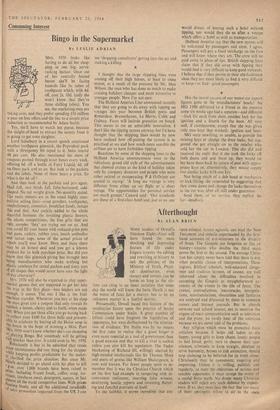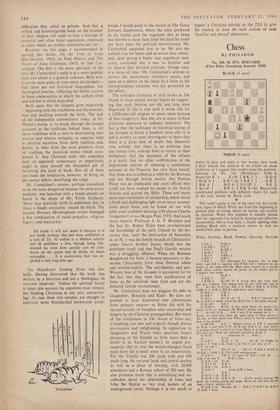Afterthought
By ALAN BRIEN
MANY readers of Orwell's Nineteen Eighty-Four will have found the most shocking and depressing feature of life under Engsoc tyranny the editing and rewriting of history to suit the policies, of the Ministry of Truth. Physi- 4. cal domination, even
slavery and torture, can be borne so long as the vic- tims can cling to an inner certainty that some day the world will know the facts. Death is not the worst of fates for a martyr, but to be an unknown martyr is a fearful destiny.
Presumably, Orwell based this feature of the totalitarian future upon the practice of Soviet Communism under Stalin. A great number of leftists could have forgiven the liquidation of opponents, but were disillusioned by the elimina- tion of evidence. Yet Stalin was by no means the first ruler to realise that a good forger is even more essential as a tool of government than a good assassin and that to kill a rival is useless unless you also kill his reputation. The Tudor blackening of Richard III, willingly abetted by high-minded intellectuals like Sir Thomas More and poets of genius like William Shakespeare, is now well known. Far fewer people seem to re- member that it was the Christian Church which set the first bad example in tampering with in- convenient testimony, inserting false witness, destroying hostile reports and inventing flatter- ing and fanciful portraits of itself.
To the faithful, it seems incredible that any
open-minded, honest agnostic can read the New Testament and remain unpersuaded by the first- hand accounts of eye-witnesses to the divinity. of Jesus. The Gospels are forgeries or lies or history—anyone who doubts the third must prove the first or the second. The average Chris- tian has simply never been told that there is any other possible choice of interpretations. Theo- logians, Biblical scholars, well-educated clergy- men and studious laymen, of course, are well informed about the difficulties involved in accepting the Gospels as straightforward ac- counts of the events in the life of Jesus. The cruxes, contradictions, inaccuracies, interpola- tions, lois-translations, obscurities and fantasies are analysed and discussed by them in common rooms and learned journals. But in church sermons and school lessons, not to mention the organs of mass communication such as television and the press, we rarely hear of the solutions because we are never told of the problems.
Any religion which must be protected from criticism because it helps old ladies to die happy, young girls to keep chaste, lonely people to feel loved, guilty men to cleanse their con- sciences, criminals to keep straight, idealists to serve humanity, heroes to risk extinction, should stop claiming to be believed for its truth alone. Christianity may be convenient, inspiring and improving. Unless it is willing, publicly and regularly, to meet the objections of serious and sensible opponents, it must accept the status of a useful State myth. No doubt many Christian readers will reject any such defence by expedi- ency. If so, they must face the fact that too many of their apologists refuse to air in the open difficulties they admit in private. And that a critical and knowledgeable book on the founder of their religion still tends to face a barrage of resentful and often bitter opposition, expressed in terms which are neither reasonable nor fair. Recently, on this page, 1 recommended in passing two books, On the Trial of Jesus (De Gruyter, 1961), by Paul Winter, and The Death of Jesus (Gollancz, 1963), by Joel Car- michael. The first is the more specialist of the two. Mr. Carmichael's study is in a more popular style and aimed at a general audience. Both start from the same point of view about the Gospels- - that these are not historical biographies, but theological treatises, reflecting the beliefs current in those communities in which the authors lived and not that in which Jesus died.
Both agree that the Gospels grew backwards —beginning with the crucifixion and the resurrec- tion and working towards the birth. The task of the independent commentator today, in Dr. Winter's words, is `to break through the Gospel accounts to the traditions behind them, to sift those traditions with a view to determining their sources and relative antiquity, to separate what is editorial accretion from early tradition and, finally, to infer from the most primitive form of tradition the historical events which occa- sioned it.' Any Christian critic who considers such an approach unnecessary or impertinent ought to deny himself the distasteful job of reviewing this kind of book. Not all of them can resist the temptation, however, of firing on the enemy before identifying the cargo.
Mr. Carmichael's volume, perhaps considered to be the more dangerous because the more easily readable, was launched with a Jonah already on board in the shape of Mr. Victor Gollancz. 'Some may conclude (with its publisher) that its thesis is finally untenable,' mused the blurb. The Sunday Mercury (Birmingham) review managed a fine combination of racial prejudice, religious bigotry and inaccuracy: His book-1 will not name it because it is not worth reading—has just been published at a cost of 25s. Its author is a Hebrew scholar and its publisher a Jew, though being fair- minded (as most Jews usually are) he com- ments on the jacket that he thinks its thesis untenable. . . . It is controversy that was ex- ploded a very long time ago.
The Manchester Evening News was also huffy. Having discovered that the book was written by a historian and not a theologian, its reviewer observed: `Unless the spiritual factor is taken into account the argument must remain, for thinking Christians at any rate, unconvinc- ing.' In case these two samples are thought, to represent some Neanderthal backwoods primi-
'Imitation.'
tivism, I would point to the review in The Times Literary Supplement, where the critic produced as his trump card the argument that as Jesus was known to have risen from the dead he could not have been the political revolutionary Mr. Carmichael supposed him to be. He also de- scribed it as `no better and no worse than others,' and, after giving a faulty and superficial sum- mary, concluded that it was 'so familiar and so absurd that detailed criticism, though easy, is a waste of time.' Mr. Carmichael's attempt to correct the anonymous reviewer's errors, and open up a debate on his thesis by a letter to the correspondence columns, was not permitted by the editor.
The orthodox dismissal of such books as The Death of Jesus almost always begins by suggest- ing that such theories are old and long since disproved. If this is true (and it seems odd for a 2,000-year-old religion to spurn ideas because of their longevity), then why are so many of these criticisms unknown to ordinary believers? The fact is that the technique of historical testing of the Gospels is barely a hundred years old—it is still a novelty to most churchgoers to learn that there is a great deal of doubt that Nazareth ever existed; that there is no evidence that any 'census ever ordered Jews to return to their birthplace; that the massacre of the infants is a myth; that no other confirmation of the improbable custom of releasing a condemned prisoner at the Passover has ever been found; that Jesus was crucified as a rebel by the Romans and not through Jewish malice; that Pontius Pilate was an implacable and cruel official who could not have washed his hands in the Jewish fashion and quoted the Bible. These and many more near-certainties of scholarship, which throw a fresh and challenging light on so many assump- tions about Jesus, can be found set out with calth, cool, confident learning in Professor Charles Guignebert's Jesus (Kegan Paul, 1935). And much more recently Professor S. G. F. Brandon and the late Dr. Robert Eisler have revolutionised our knowledge of the early Church by the dis- covery that, until the destruction of Jerusalem in AD 70, it was the Jewish branch of Christianity under Jesus's brother James which was the dominant trunk and that Paul's Gentile version was a struggling offshoot. When the Romans slaughtered the Jews, it became necessary to dis- sociate Christianity from these Oriental rebels and trouble-makers. The anti-Semitic and pro- Western bias of the Gospels is accounted for by the fact that they were later justifications of Jesus as the universal risen God and not the defeated Jewish revolutionary.
Mr. Carmichael does not disguise his debt to Guignebert, Brandon and Eisler. He does not pretend to have discovered new information from primary sources—as Eisler did with his reconstructions of Josephus after censorship and forgery by the Christian propagandists. But many of the conclusions in The Death of Jesus are, if anything, too new and original, though always provocative and enlightening. In opposition to Guignebert and Winter (who describes Jesus's cleansing of the Temple as 'little more than a brawl ' in an Eastern bazaar'), he argues per- suasively that to rout the money-changers Jesus must have led a small army in an insurrection. For the Temple was 200 yards wide and 450 yards long, the national bank and ,central market as well as a place of worship, with 20,000 attendants and a Roman cohort of 500 men. He also produces much that is stimulating and un- orthodox about the relationship of Jesus and John the Baptist as two rival leaders of an underground revolt. Perhaps it is too much to expect a Christian scholar in the TLS to give his readers at least the bare outline of such `familiar and absurd' deductions.







































 Previous page
Previous page